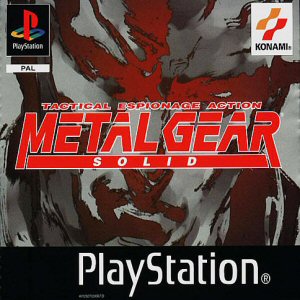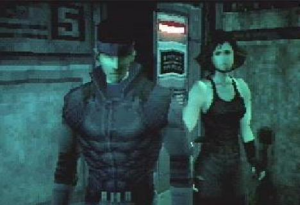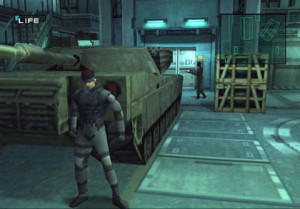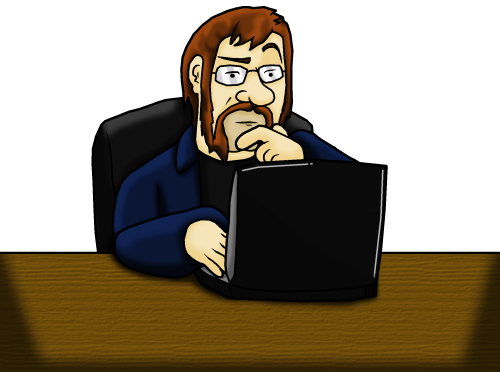Hiding in Cardboard Boxes – a Review of the Original Metal Gear Solid (on PSX)
 At the time of writing this, Metal Gear Solid 4 is just around the corner on the releases list. To commemorate the occasion and remind myself of the story, I thought that I would push my PS3 to its limits by playing an outdated game created back when high definition was just a term for a tall old man’s very wrinkly forehead.
At the time of writing this, Metal Gear Solid 4 is just around the corner on the releases list. To commemorate the occasion and remind myself of the story, I thought that I would push my PS3 to its limits by playing an outdated game created back when high definition was just a term for a tall old man’s very wrinkly forehead.
We all should know the story by now: veteran soldier and all-round badass Solid Snake (not a euphemism, thank you very much) is brought out of retirement to take down the most recent crew of oddballs populating his old unit, FOXHOUND. FOXHOUND have gone rogue and joined up with an army of genetically-enhanced soldiers to take over a secret military installation, Shadow Moses, home of the latest incarnation of super walking nuclear-equipped tank Metal Gear. Armed only with his wits and whatever weaponry he can find, Snake is aided by a whole crew of people who speak to him via “codec” (i.e. “radio”) in the hopes that he will be able to take down the rogue soldiers and their leader, who happens to be a clone of himself called Liquid Snake. The rest is unimportant, but there’s a lot of it.
The first noticeable criticism is the obvious one. Time is a fickle mistress on technology. There are very few very good examples of games that survive the test of time, and a lot of them are admittedly from the 2D era. Classics like Sonic and Mario still feel good to play even today because they have a timeless cartoon appeal to them – that and they still play fantastically well due to how well they were created. In fact, SEGA have just woken up to the fact that their most popular Sonic games are all side-scrolling platformers, and from what I understand they have just spent a lot of money developing a game engine to run a 2D side-scroller but in 3D. Let’s have a big hand for SEGA, people, because now they’ve taken a step backwards maybe they can relearn their ABCs, pass their basic maths class and rejoin the big boys in the 21st century.
I digress. The point I’m trying to make is that seminal classics such as Monkey Island and Broken Sword are still great fun to play (if you can get the damned things to run on your snobby high-end PCs). Unfortunately, Metal Gear Solid was created during the period following directly on from when 2D went out of style and 3D was the new big thing. Even more unfortunately, games of the PSone period are now looked back upon like samples of 80s fashion. Oh dear.

Like 80’s fashion, Metal Gear Solid looked amazing at the time, but creating a game that looks like it did today would be something of a fashion faux-par. I hate to refer to it as “fugly”, but when the all the characters are coloured bricks haphazardly joined together with fine string like some sort of child’s hackneyed puppet project it’s hard not to. On the subject of bricks, now would be a very good time to bring up the main character Solid Snake’s response times because he handles like one.
I suspect it must just be my modern pampered sense of how a game should perform, but MGS is not a game that can be handled delicately. Like a mother trying to breast-feed while wearing oven gloves, controlling Snake feels like there is a layer of cotton wool between your thumb and the controller. Game response seems to be behind the button presses by about a second, and at times you often find yourself pressing buttons down harder like on a television remote control you know is low on battery power – hopefully suffocating the button with your thumb will coax out a little bit more juice, but it never works like that.
These staggering examples of outdated game design aside, I actually enjoyed the game. Gameplay felt like taking candy from a sack of flour dressed as a baby I must admit, but that is my own fault for playing the game so much in my early teenage years. Knowing is half the battle, in which case some younger version of myself had kindly left out intricate maps of the Shadow Moses facility with quirky post-it notes detailing shortcuts and traps in the recesses of my mind, just in case older me should stagger in on a later date half-drunk and inclined to get a bit nostalgic. Go me!
Even around its release, MGS was always criticised for being horribly short. That didn’t matter in my early teenage years – my complete lack of common sense or hand-eye coordination meant that on my first play-through the end credits clocked in at around 18 hours1. My most recent play-through clocked in at around 5 hours, which is still a slow time, but decidedly shorter.
I could not help but feel that although a lot of the areas in the game were atmospheric and well conceived, there just wasn’t enough in them or of them. One of the most annoying common storyline features in MGS was the amount of back-tracking that was required: first there’s going back halfway across the first disc to get a sniper rifle, then there’s escaping the torture chamber and trekking the path you just took to fetch the rifle. Finally, there is the absurd seemingly last-minute added journey on disc two to change a card key into different shapes by back-tracking between a command room to various rooms of different temperature2.

While backtracking, it becomes readily apparent that Shadow Moses suffers from a lack of patrol coverage. Alright, so the PSone could not handle the burden of lots of enemies on screen at once, but all I am suggesting is that if perhaps Hideo Kojima and his crew had designed the areas to be less empty but narrower, coaxing us towards close-encounters rather than providing us with Saharan-like expanses in which we can just walk in a wide arc around the guards, then maybe there would be more entertainment to be had while taking the round-robin bullshit tour of Shadow Moses. Maybe trying to elevate the AI of the so called “next-generation genome soldiers” above that of your average toaster oven would have also been a good move.
The story still holds up. This is classic Jean Claude-Van Damme late 80’s action spy-flick fun, before Hideo Kojima got all weird and surreal with his works. Not that I’m complaining, I like when the later MGS titles decide to go all barmy3. MGS also shows when Hideo was still learning how to put morals and educational messaging into his works, so it is no surprise when the secret agent and his friends go off the topic of being in a freezing cold military base surrounded by crack soldiers looking to turn their arses into Swiss cheese to instead talk about the nuclear missile radioactive waste figures of 1997 and how democratic vote can prevent the stockpiling of armaments. These tangents often feel like someone in the MGS script department realised that the story was perhaps a little too direct and to the point, so they took the action of copying and pasting large chunks of text from a UN council meeting on nuclear disarmament and from science journals on cloning into parts of the story where Snake could be doing something else…like allowing us to control him and do something more interesting, for example.
Even the ending feels a little bit heavy on the crowbarred-in-at-the-very-last-minute moral message. I’ve always disliked it due to the common use of the word “life” and its variations of imperative.
Naomi: “Oh, let’s enjoy living life! What are you going to do?”
Snake: “Me? Why I’m going to live! I want to enjoy life”, etc.
Honestly, the next time you see the MGS ending, pour yourself a shot of strong liquor every time “life” is mentioned. You could be in for a good night.
On the flip side, the voice acting is very good, if you like that sort of thing. It certainly makes the numerous cutscenes and codec calls more tolerable, and in many cases can make you regret that the PSone lacked the power to produce polygonal facial expressions.
I have had the fortune of playing the Nintendo Gamecube exclusive (hack, spit, hiss) remake of MGS, subtitled “The Twin Snakes”4. While playing MGS, I couldn’t help but feel that what I actually wanted to be doing was playing the remake, and deep down that saddened me a little. To think that I may have reached a point where I crave sleeker graphics. Still, I’ll have the smug knowledge of knowing that I was there when MGS first came out. There must be some poor sods out there who will be wading into MGS4 without having played the original. More loss for them, I say.
MGS is a classic. It may have tarnished a little over the years, but its iconic story and era-defining gameplay still shines through at the heart of it. Even if the graphics do look worse than an episode of the Clangers.
Postscript (07/03/2015)
If you fancy finding out more about Metal Gear Solid and its sequels, check out the little guide article I wrote as an introduction to the series.
- Which was quite ironic, considering that at the start of the game “the terrorists are all set to launch their nuclear missile in about 18 hours”. Don’t ask me how I remember that, it’s probably a mental post-it note thing. ↩
- It’s all needlessly complicated an bloody stupid. All you need to know is that you have to travel back to two different rooms, wait around for the card key to change, and then hurry back like buggery to the command room before the card returns to its default shape. VGCats had a better idea on how to short-cut the problem. ↩
- Codec instructions to “turn off the console as you’ve failed the game” were a particular favourite of mine. ↩
- Polished up with needless Matrix-style cutscene direction and MGS2 graphics. ↩
Post by Sean Patrick Payne+ | April 22, 2008 at 10:55 pm | Reviews, Video Games | No comment
Tags: game review, Metal Gear Solid, MGS, Solid Snake, The Twin Snakes

